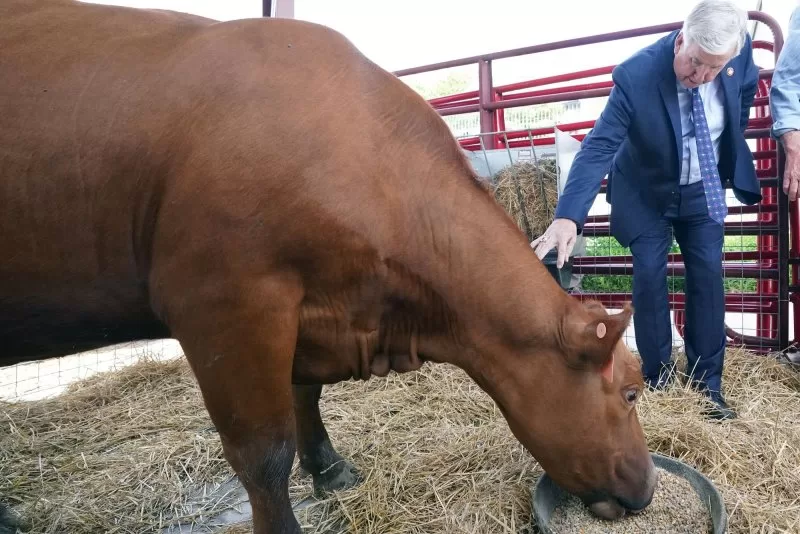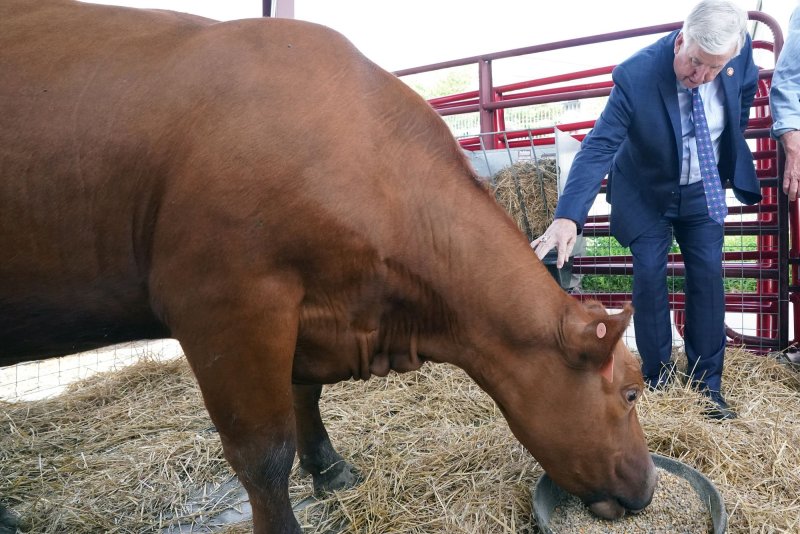1 of 2 | Gov. Mike Parson, R-Missouri, inspects a red angus cow during a May 2021 visit to the St. Louis Science Center where Parson was on hand to present a proclamation recognizing May as “Beef Month” in Missouri. In April, a Texas poultry facility stopped production and was ordered to cull 1.6 million laying hens and 337,000 pullets at a facility near New Mexico’s border due to the bird flu’s rapid spread. File Photo By Bill Greenblatt/UPI |
License PhotoMay 22 (UPI) — The Centers for Disease Control and Prevention on Wednesday reported a second and similar case of the bird flu identified this time in Michigan tied to cows amid an outbreak beginning on a Texas dairy farm.
Despite this, the CDC’s risk public assessment for the general population “remains low” but the organization says this new case underscores “the importance of recommended precautions in people with exposure to infected or potentially infected animals,” which it said include people with long or unprotected exposure to infected birds, livestock and other animals, or in that type of environment.
The agency said similar to the Texas case — first U.S. human bird flu case linked to an outbreak in dairy cows and the first likely case of human infection from a cow globally — the Michigan individual is a dairy farm worker where the virus had been identified in cows, and that while a nasal swab test originally tested negative for influenza, an eye swab test sent to the CDC identified it as bird flu, which they say indicates eye infections in both cases with only reported eye symptoms in the patients.
The CDC says they have been eyeing influenza surveillance systems closely, “particularly in affected states, and there has been no sign of unusual influenza activity in people, including in syndromic surveillance.” The Michigan dairy worker who was being monitored because of their work exposure to H5N1-infected cattle reported symptoms to local health officials, they said.
Conjunctivitis, better known as an eye infection, has been associated with previous human infections with avian influenza A viruses and is part of the current CDC case definition for A(H5N1) surveillance, according to the CDC, which added that while it’s not yet known exactly how eye infections result from avian influenza exposures, “it may be from eye contamination, potentially with a splash of contaminated fluid, or touching the eyes with something contaminated with the virus, such as a hand.”
High levels of the virus have been found in unpasteurized milk from H5N1-infected cows, the federal agency said.
“Given the high levels of the virus in raw milk from infected cows, and the extent of the spread of this virus in dairy cows, similar additional human cases could be identified,” the CDC said, adding that “sporadic human infections with no ongoing spread will not change the CDC risk assessment for the U.S. general public,” which they consider to be low.
A Texas poultry facility in April stopped production and was ordered to cull 1.6 million laying hens and 337,000 pullets — or young female chickens — at a facility near New Mexico’s border due to the virus’ rapid spread.
Last year, scientists and researchers began sounding the alarm on dangerous changes to the highly pathogenic H5N1 avian influenza from seasonal to year-round infections, saying at the time that an urgent coordinated national response was needed.
But the Centers for Disease Control says it has been taking steps to mitigate any future bird flu cases such as by holding weekly engagements with state and local health officials “around increasing their preparedness posture, updated interim recommendations for worker protection to include those who work with dairy cows,” health alerts and several other steps.
Earlier this month, the federal government announced a series of new initiatives aimed to monitor and prevent the bird flu as it got reported days later how the H5N1 avian flu virus was discovered in a small number of wild New York City birds.

